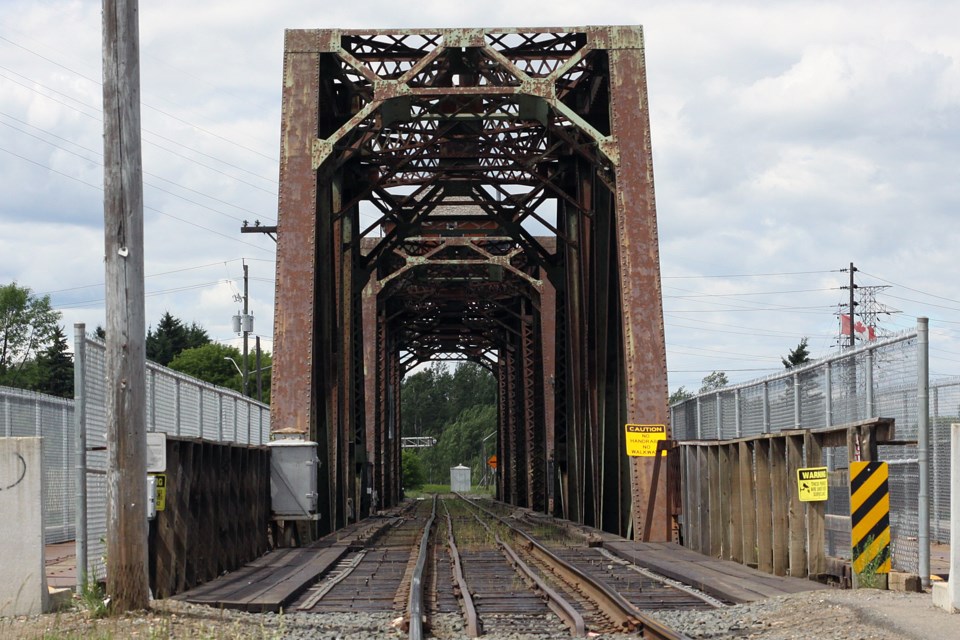THUNDER BAY – The legal battle to reopen the James Street Swing Bridge does not appear to be over.
Thunder Bay mayor Keith Hobbs on Wednesday said CN Rail has informed the city that it intends to appeal last month’s Ontario Court of Appeal decision that ordered the railway to reopen the bridge to vehicular traffic.
The span, which connects Thunder Bay to the Fort William First Nation, has been closed to motor vehicles since a fire broke out on the northern approach spans on the evening of Oct. 29, 2013, though trains were able to resume crossing that same week.
Hobbs said the city was “beyond disappointed” and “outraged” by the railway’s decision to prolong the legal saga.
“It’s not too much of a surprise. We anticipated this,” Hobbs said. “As far as I’m concerned and we’re concerned, CN is in contempt of a court order by the Ontario Court of Appeal. They need to act on that and open the bridge as they’ve been directed by the Ontario Court of Appeal.”
The Ontario Court of Appeal last month ruled in favour of the city, that CN must provide a perpetual right to cross for pedestrian and vehicular traffic to meet its requirements from the 1906 agreement that allowed for the construction of the bridge.
That ruling overturned a previous Ontario Superior Court of Justice decision that CN was not responsible for maintaining the century-old bridge to modern standards.
CN spokesman Patrick Waldron said the railway does not believe the bridge can be reopened with “simple maintenance,” and has started a process involving engineering and construction firms to perform “substantial work” on the span.
“We continue to offer a solution that would improve the deck of the railway bridge to safely accommodate vehicular traffic, including emergency vehicles and heavier vehicles, such as school buses – something the road bridges did not accommodate,” Waldron said.
“Given the limited volume of rail traffic on the bridge, this is a very effective solution that could be implemented quickly and at no cost to the City of Thunder Bay and Fort William First Nation.”
Waldron said CN intends to seek “guidance from the courts on the scope of its obligations under the 1906 agreement.”
The city had rejected offers from CN more than three years ago that included sharing the rail deck. Hobbs insisted the appeal court ruling means CN must provide two-way traffic.
“It would be a nightmare to have one lane. It would just be a nightmare,” Hobbs said. “Our engineers have looked at that. Our planning people have looked at that. As a former police officer, it would be a traffic and safety nightmare worse than what we’ve got now. You’d have traffic backed up for miles at rush hour and you’re probably going to have more accidents.”
Dougall Media last month reported the city had spent more than $1.3 million in legal expenses as of the end of May in pursuing the bridge through the courts.
“If we have to fight this at the Supreme Court level that’s a huge expense for the city. Again, do we just ignore contracts and say they don’t mean anything?” Hobbs said, adding the city’s legal team believes the chances of the case being heard by the Supreme Court are “slim to none.”
“When you’re in this business, sometimes it’s the cost of doing business when you have to take people on. We’ve taken CN on because they didn’t fulfill their duty initially. The Ontario Court of Appeal has said to do it, you’re wrong. That agreement says in perpetuity you have to keep that bridge open to vehicular and pedestrian traffic.”
During prepared remarks, Hobbs referenced the CN-owned Rat River Bridge in Minnesota that was destroyed by fire in 2015, yet a new bridge was constructed in nine days.
Why hasn’t that happened in Thunder Bay, Hobbs asked.
“CN are not good corporate citizens. Not to the city of Thunder Bay, not to our mind,” Hobbs said. “Our council is very outraged by this decision and the lack of movement on that bridge. Lives are being impacted and they don’t seem to give a damn.”
City officials said CN must submit an appeal by Sept. 10 and it would be up to council to decide whether to initiate any legal process to try to enforce the appeal court’s ruling.
